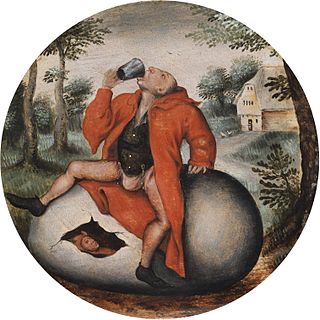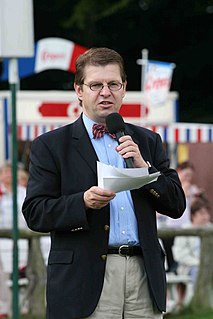Related Research Articles

Black tie is a semi-formal Western dress code for evening events, originating in British and American conventions for attire in the 19th century. In British English, the dress code is often referred to synecdochically by its principal element for men, the dinner suit or dinner jacket. In American English the equivalent term tuxedo is common. The dinner suit is a black, midnight blue or white two- or three-piece suit, distinguished by satin or grosgrain jacket lapels and similar stripes along the outseam of the trousers. It is worn with a white dress shirt with standing or turndown collar and link cuffs, a black bow tie, typically an evening waistcoat or a cummerbund, and black patent leather dress shoes or court pumps. Accessories may include a semi-formal homburg, bowler, or boater hat. For women, an evening gown or other fashionable evening attire may be worn.

A codpiece is a covering flap or pouch that attaches to the front of the crotch of men's trousers, enclosing the genital area. It may be held closed by string ties, buttons, folds, or other methods. It was an important fashion item of European clothing during the fifteenth and sixteenth centuries. In the modern era, clothing devices with similar functions as codpieces are worn in some styles of underwear, in the leather subculture, and in performance costumes, such as for rock music and metal musicians. A similar device with rigid construction, an athletic cup, is used as protective underwear for male athletes.

Shorts are a garment worn over the pelvic area, circling the waist and splitting to cover the upper part of the legs, sometimes extending down to the knees but not covering the entire length of the leg. They are called "shorts" because they are a shortened version of trousers, which cover the entire leg, but not the foot. Shorts are typically worn in warm weather or in an environment where comfort and air flow are more important than the protection of the legs.
In fashion design, primarily in ready-to-wear lines, boyfriend is any style of women's clothing that was modified from a corresponding men's garment. Examples include boyfriend jackets, boyfriend jeans, and boyfriend blazers, which are often more unisex or looser in appearance and fit most women. These include jackets or trousers, though these are still designed for the female form.

A suit, lounge suit, or business suit is a set of clothes comprising a suit jacket and trousers of identical textiles worn with a collared dress shirt, necktie, and dress shoes. It is considered informal wear in Western dress codes. The lounge suit originated in 19th-century Britain as a more casual alternative for sportswear and British country clothing. After replacing the black frock coat in the early 20th century as regular daywear, a sober one-colored suit became known as a lounge suit.

Business casual is an ambiguously defined Western dress code that is generally considered casual wear but with smart components of a proper lounge suit from traditional informal wear, adopted for white-collar workplaces. This interpretation typically including dress shirt, necktie, and trousers, but worn with an odd-coloured blazer or a sports coat instead.

Overalls, also called bib-and-brace overalls or dungarees, are a type of garment usually used as protective clothing when working. The garments are commonly referred to as a "pair of overalls" by analogy with "pair of trousers".

Simpsons of Piccadilly was a large retail store situated at 203-206 Piccadilly in central London. It was created by Alexander Simpson and architect Joseph Emberton. When it opened in April 1936 it was the largest menswear store in Britain, and is now a Grade I listed building due to its innovative construction. Its original purpose was to house the entire range of clothing provided by the tailoring company S. Simpsons and DAKS. It was later purchased by the Waterstones chain of bookshops, and currently serves as their flagship store.

Joseph Ephraim Casely-Hayford was a British fashion designer. Beginning in the mid-1980s he established an international reputation as one of the UK's most respected and consistently relevant designers of men's and womenswear clothing. He was appointed an Officer of the Order of the British Empire, for services to the fashion industry, in the 2007 Birthday Honours.

E. Tautz & Sons is a men's clothing brand founded on Oxford Street, London in 1867 as Edward Tautz & Sons. It specialised in sportswear and trousers. The brand was acquired in 2005 by Patrick Grant and focuses on sportswear and casualwear, manufacturing many of its products in the United Kingdom.
Ports is an international luxury fashion house founded by Japanese Canadian fashion designer Luke Tanabe (1920–2009) in Toronto in 1961. It specializes in luxury women's and men's ready-to-wear as well as accessories. Acquired by Chinese Canadian brothers Alfred Chan and Edward Tan in 1989, Ports expanded into the Chinese market in the early 1990s where its parent company — which traded on the Hong Kong Stock Exchange from 2003 to 2018 and has since been privatized — now operates more than 300 retail stores. Sub-brands of the fashion house include Ports (International) in China and Asia as well as Ports 1969, with subsidiaries in Milan and New York City as well as a flagship store in Paris, for global distribution.
Androgyny is the possession of both masculine and feminine characteristics in humans. In comparison, hermaphroditism is the possession of both male and female reproductive organs in plants and animals. Androgyny may be expressed with regard to biological sex, gender identity, or gender expression.

Hackett Limited is a British multi-channel retailer of clothing for men and boys, with a broad range of apparel and accessories. It was founded in 1983 in London, England. As of June 2019, the company had 160 stores globally, with its flagship store at 14 Savile Row in London.

Timothy Charles Peto Everest is a Welsh tailor and fashion designer. He moved to London in his early twenties to work with the Savile Row tailor Tommy Nutter. He then became one of the leaders of the New Bespoke Movement, which brought designer attitudes to the traditional skills of Savile Row tailoring.

Richard James is a bespoke Savile Row tailors and contemporary menswear company. It was founded in 1992 by designer Richard James, a graduate of Brighton College of Art and a former buyer for the London boutique Browns, and his business partner Sean Dixon. Richard James has won both the British Fashion Council's Menswear Designer of the Year and Bespoke Designer of the Year awards.
Men's Fashion Week, typically held twice a year in January and June, is a series of international fashion industry events where menswear collections are shown to buyers, stylists, the media, and in some cases, the general public.
Crolla was a 1980s British high fashion brand and boutique founded by Scott Crolla and Georgina Godley in Mayfair's Dover Street. Always niche, it was influential for its juxtaposition of unusual and vintage fabrics and traditional tailoring. Describing the brand's signature at the time, Scott Crolla said: "My clothes are for someone who disregards fashion but enjoys fabrics… I would call it a calculated disregard for conventional taste." In the book London: After Fashion, Alistair O’Neill described the look as: “as odd a combination as Coward in Las Vegas, but it communicated a vision of Englishness just as brashly."

John Michael Ingram was an influential British menswear designer and retailer of the 1950s and '60s who founded the John Michael fashion brand, followed by a range of successful retail concepts, before establishing one of the first fashion forecasting agencies in the 1970s.

Social rules typically restrict people's dress according to gender. Trousers were traditionally a male form of dress, frowned upon for women. However, during the 1800s, female spies were introduced and Vivandières wore a certain uniform with a dress over trousers. Women activists during that time would also decide to wear trousers, for example Luisa Capetillo, a women's rights activist and the first woman in Puerto Rico to wear trousers in public.

Fashions of the 2020s represent a departure from 2010s fashion and have thus far been largely inspired by fashions of the early to mid 2000s as well as the 1960s and 1980s. Popular 2020s brands in the UK, US, and Australia include Adidas, Nike, Globe International, Vans, Kappa, Tommy Hilfiger, Asics, Ellesse, Ralph Lauren, Forever 21, The North Face and Superdry.
References
- ↑ HASEGAWA Yoshimi (13 March 2018). マーク・チョーとジェレミー・ハケットに訊く──英国的紳士の着こなし. GQ Japan Edition (in Japanese). Retrieved 18 September 2020.
- 1 2 3 Acharya, Dipal (18 October 2013). "Jeremy Hackett's urbane retreat in Stockwell". Evening Standard. Retrieved 13 September 2014.
- ↑ Horwell, Veronica (3 July 2014). "John Michael Ingram obituary". The Guardian. Retrieved 7 July 2014.
- ↑ Menkes, Suzy (11 January 2010). "Hackett: A 'Heritage' That's Oh-So-British". The New York Times. Retrieved 15 October 2010.
- ↑ "Keeping the British end up". Matt Pomroy. 10 April 2017. Retrieved 18 May 2017.
- ↑ Lemos, Jain. "Book Review: Mr Classic by Jeremy Hackett and Garda Tang". About the Image. Archived from the original on 19 February 2010. Retrieved 19 January 2016.
- ↑ "Archived copy". Archived from the original on 16 July 2011. Retrieved 16 March 2010.
{{cite web}}: CS1 maint: archived copy as title (link) - ↑ Hackett, Jeremy. "Jeremy Hackett's 10 style tips". Men's Health. Retrieved 13 September 2014.
- ↑ Lacey, Hester (17 January 2014). "Success story: nine hints from top British clothing retailer Jeremy Hackett". Forbes. Retrieved 13 September 2014.